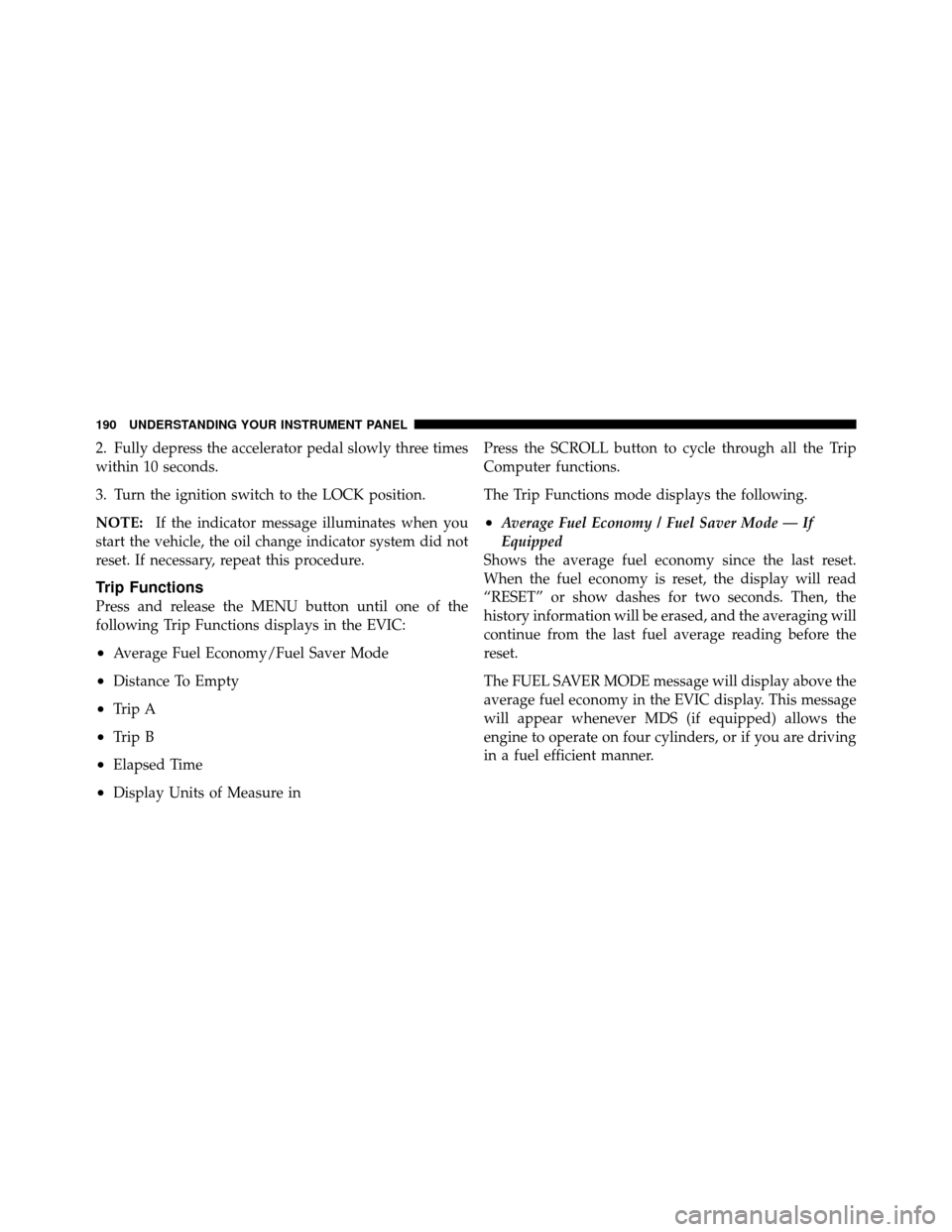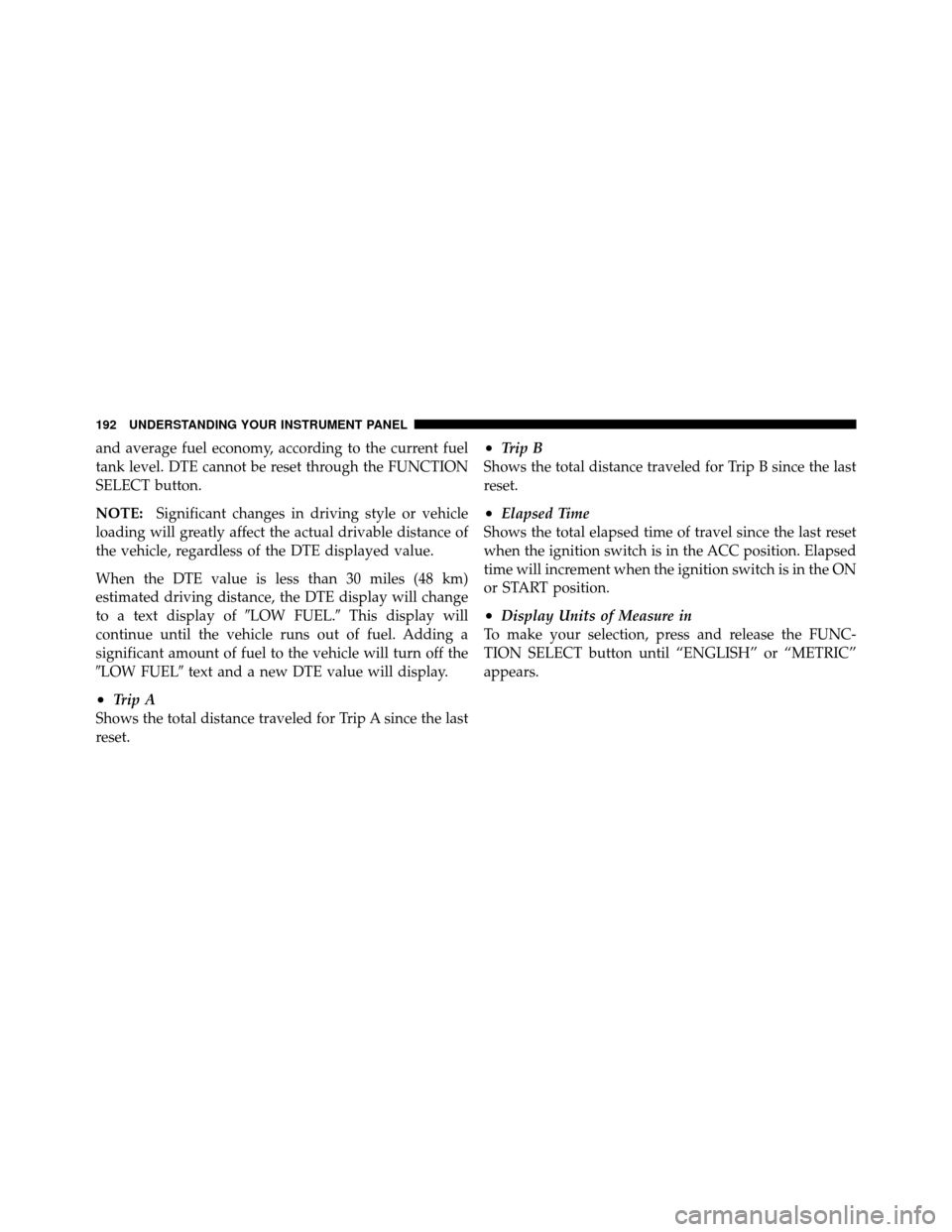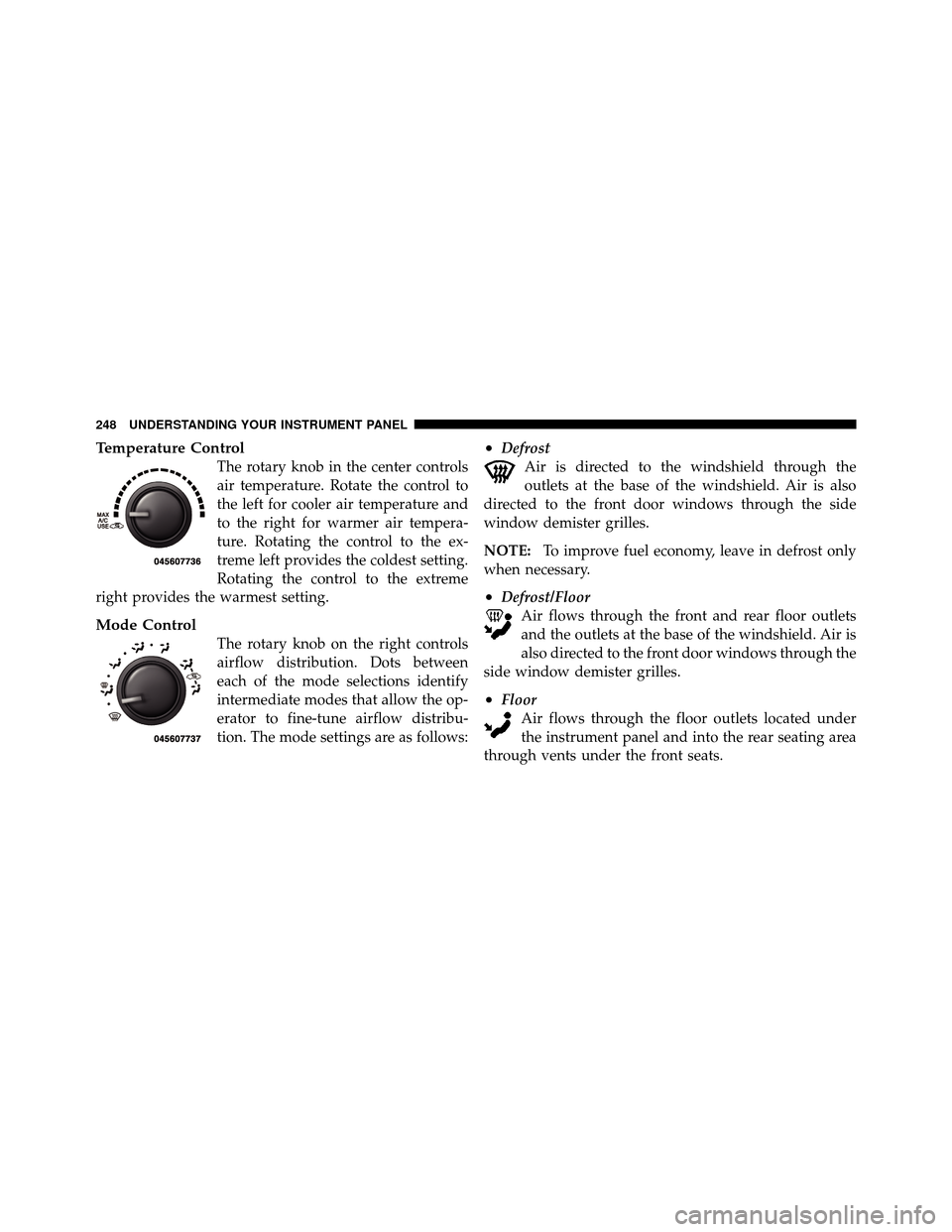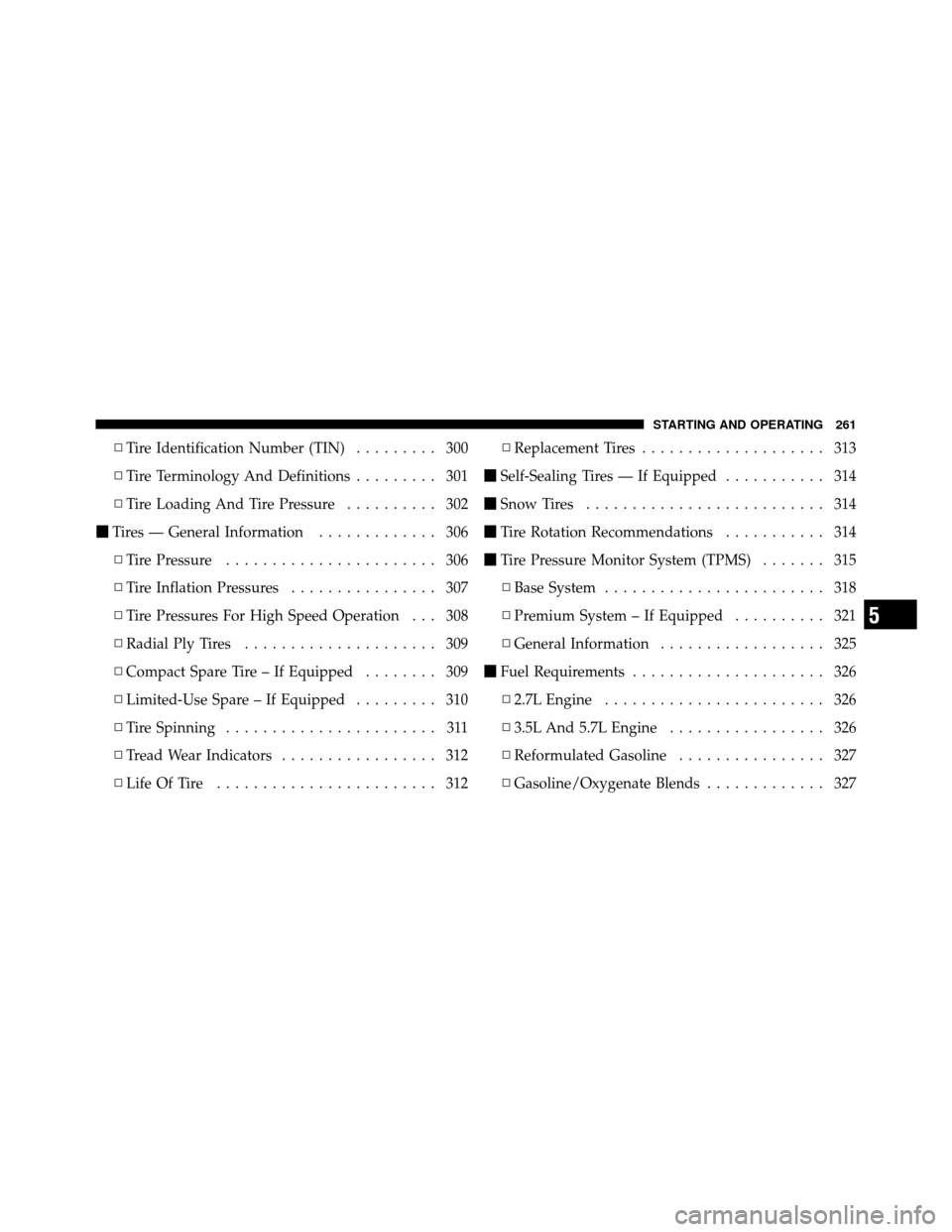Page 186 of 484

25. Malfunction Indicator Light (MIL)The Malfunction Indicator Light (MIL) is part of
an onboard diagnostic system called OBD. The
OBD system monitors engine and automatic
transmission control systems. The MIL will turn on when
the key is in the ON position before engine start. If the
MIL does not come on when turning the key from LOCK
to ON, have the condition checked promptly.
Certain conditions such as a loose or missing gas cap,
poor fuel quality, etc., may illuminate the MIL after
engine start. The vehicle should be serviced if the MIL
stays on through several of your typical driving cycles. In
most situations, the vehicle will drive normally and will
not require towing.CAUTION!
Prolonged driving with the MIL on could cause
damage to the engine control system. It also could
affect fuel economy and drivability. If the MIL is
flashing, severe catalytic converter damage and
power loss will soon occur. Immediate service is
required.
WARNING!
A malfunctioning catalytic converter, as referenced
above, can reach higher temperatures than in normal
operating conditions. This can cause a fire if you
drive slowly or park over flammable substances such
as dry plants or wood or cardboard, etc. This could
result in death or serious injury to the driver, occu-
pants or others.
4
UNDERSTANDING YOUR INSTRUMENT PANEL 185
Page 190 of 484

•ECO (Fuel Saver Indicator) — if equipped
•SERVICE AWD SYSTEM — All Wheel Drive (AWD)
system is not functioning properly and service is
required.
•Channel # Transmit
•Channel # Training
•Channel # Trained
•Clearing Channels
•Channels Cleared
•Did Not Train
•Insert Key/Turn To Run (refer to “Remote Starting
System” in “Things To Know Before Starting Your
Vehicle”)
•Check Gascap (refer to “Adding Fuel” in “Starting
And Operating”)
•Oil Change Required (with a single chime)
Oil Change Required
Your vehicle is equipped with an engine oil change
indicator system. The “Oil Change Required” message
will flash in the EVIC display for approximately 10 sec-
onds after a single chime has sounded to indicate the next
scheduled oil change interval. The engine oil change
indicator system is duty cycle based, which means the
engine oil change interval may fluctuate dependent upon
your personal driving style.
Unless reset, this message will continue to display each
time you turn the ignition switch to the ON position. To
turn off the message temporarily, press and release the
MENU button. To reset the oil change indicator system
(after performing the scheduled maintenance) perform
the following procedure:
1. Turn the ignition switch to the ON position. (Do not
start the engine).
4
UNDERSTANDING YOUR INSTRUMENT PANEL 189
Page 191 of 484

2. Fully depress the accelerator pedal slowly three times
within 10 seconds.
3. Turn the ignition switch to the LOCK position.
NOTE:If the indicator message illuminates when you
start the vehicle, the oil change indicator system did not
reset. If necessary, repeat this procedure.
Trip Functions
Press and release the MENU button until one of the
following Trip Functions displays in the EVIC:
•Average Fuel Economy/Fuel Saver Mode
•Distance To Empty
•Trip A
•Trip B
•Elapsed Time
•Display Units of Measure in Press the SCROLL button to cycle through all the Trip
Computer functions.
The Trip Functions mode displays the following.
•Average Fuel Economy / Fuel Saver Mode — If
Equipped
Shows the average fuel economy since the last reset.
When the fuel economy is reset, the display will read
“RESET” or show dashes for two seconds. Then, the
history information will be erased, and the averaging will
continue from the last fuel average reading before the
reset.
The FUEL SAVER MODE message will display above the
average fuel economy in the EVIC display. This message
will appear whenever MDS (if equipped) allows the
engine to operate on four cylinders, or if you are driving
in a fuel efficient manner.
190 UNDERSTANDING YOUR INSTRUMENT PANEL
Page 192 of 484
This feature allows you to monitor when you are driving
in a fuel efficient manner, and it can be used to modify
driving habits in order to increase fuel economy.•Distance To Empty (DTE)
Shows the estimated distance that can be traveled with
the fuel remaining in the tank. This estimated distance is
determined by a weighted average of the instantaneous
Fuel Saver Mode — OnFuel Saver Mode — Off
4
UNDERSTANDING YOUR INSTRUMENT PANEL 191
Page 193 of 484

and average fuel economy, according to the current fuel
tank level. DTE cannot be reset through the FUNCTION
SELECT button.
NOTE:Significant changes in driving style or vehicle
loading will greatly affect the actual drivable distance of
the vehicle, regardless of the DTE displayed value.
When the DTE value is less than 30 miles (48 km)
estimated driving distance, the DTE display will change
to a text display of �LOW FUEL.�This display will
continue until the vehicle runs out of fuel. Adding a
significant amount of fuel to the vehicle will turn off the
�LOW FUEL� text and a new DTE value will display.
•Trip A
Shows the total distance traveled for Trip A since the last
reset.
•Trip B
Shows the total distance traveled for Trip B since the last
reset.
•Elapsed Time
Shows the total elapsed time of travel since the last reset
when the ignition switch is in the ACC position. Elapsed
time will increment when the ignition switch is in the ON
or START position.
•Display Units of Measure in
To make your selection, press and release the FUNC-
TION SELECT button until “ENGLISH” or “METRIC”
appears.
192 UNDERSTANDING YOUR INSTRUMENT PANEL
Page 249 of 484

Temperature Control
The rotary knob in the center controls
air temperature. Rotate the control to
the left for cooler air temperature and
to the right for warmer air tempera-
ture. Rotating the control to the ex-
treme left provides the coldest setting.
Rotating the control to the extreme
right provides the warmest setting.
Mode Control
The rotary knob on the right controls
airflow distribution. Dots between
each of the mode selections identify
intermediate modes that allow the op-
erator to fine-tune airflow distribu-
tion. The mode settings are as follows:
•Defrost Air is directed to the windshield through the
outlets at the base of the windshield. Air is also
directed to the front door windows through the side
window demister grilles.
NOTE: To improve fuel economy, leave in defrost only
when necessary.
•Defrost/Floor Air flows through the front and rear floor outlets
and the outlets at the base of the windshield. Air is
also directed to the front door windows through the
side window demister grilles.
•Floor Air flows through the floor outlets located under
the instrument panel and into the rear seating area
through vents under the front seats.
248 UNDERSTANDING YOUR INSTRUMENT PANEL
Page 262 of 484

▫Tire Identification Number (TIN) ......... 300
▫ Tire Terminology And Definitions ......... 301
▫ Tire Loading And Tire Pressure .......... 302
� Tires — General Information ............. 306
▫ Tire Pressure ....................... 306
▫ Tire Inflation Pressures ................ 307
▫ Tire Pressures For High Speed Operation . . . 308
▫ Radial Ply Tires ..................... 309
▫ Compact Spare Tire – If Equipped ........ 309
▫ Limited-Use Spare – If Equipped ......... 310
▫ Tire Spinning ....................... 311
▫ Tread Wear Indicators ................. 312
▫ Life Of Tire ........................ 312 ▫
Replacement Tires .................... 313
� Self-Sealing Tires — If Equipped ........... 314
� Snow Tires .......................... 314
� Tire Rotation Recommendations ........... 314
� Tire Pressure Monitor System (TPMS) ....... 315
▫ Base System ........................ 318
▫ Premium System – If Equipped .......... 321
▫ General Information .................. 325
� Fuel Requirements ..................... 326
▫ 2.7L Engine ........................ 326
▫ 3.5L And 5.7L Engine ................. 326
▫ Reformulated Gasoline ................ 327
▫ Gasoline/Oxygenate Blends ............. 327
5
STARTING AND OPERATING 261
Page 263 of 484

▫E85 Usage In Non-Flex Fuel Vehicles ...... 327
▫ MMT In Gasoline .................... 328
▫ Materials Added To Fuel ............... 329
▫ Fuel System Cautions ................. 329
▫ Carbon Monoxide Warnings ............ 330
� Adding Fuel ......................... 330
▫ Fuel Filler Cap (Gas Cap) .............. 330
▫ Loose Fuel Filler Cap Message ........... 332
� Vehicle Loading ...................... 333
▫ Vehicle Certification Label .............. 333
▫ Gross Vehicle Weight Rating (GVWR) ...... 334
▫ Gross Axle Weight Rating (GAWR) ........ 334▫
Overloading ........................ 334
▫ Loading ........................... 335
� Trailer Towing ........................ 335
▫ Common Towing Definitions ............ 335
▫ Trailer Hitch Classification .............. 338
▫ Trailer Towing Weights (Maximum Trailer
Weight Ratings) ..................... 339
▫ Trailer And Tongue Weight ............. 340
▫ Towing Requirements ................. 341
▫ Towing Tips ........................ 346
�
Recreational Towing (Behind Motorhome, Etc.). . 348
▫ Two-Wheel Drive And All-Wheel Drive .... 348
262 STARTING AND OPERATING